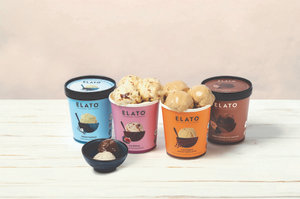A buoyant labels market, and a growing number of packaging applications, will be reflected on the Currie Group stand at PacPrint. PKN speaks to Mark Daws, director of labels & packaging ANZ, to find out more.

The Currie Group stand at PacPrint, the biggest at the show, will make quite a statement, with a brand new look, and some of the latest label and packaging technology on display. And rightly so, with labels and packaging among the strongest performing print sectors.
Unlike much of the commercial print industry, both labels and packaging fared well in the Covid years, with labels in particular thriving – in large part due to the increased at-home demand for food, beverage and other FMCG products.
Mark Daws, director of labels and packaging ANZ at Currie Group says that while the record highs of self-adhesive label production during the peak of the pandemic have somewhat receded, the industry is still well ahead of where it was pre-pandemic. He says, “Month-on-month it is still well up on pre-pandemic levels for our customers; in general the market is positive.”
According to Daws, both digital and conventional flexo markets are providing growth opportunities. Currie Group installed four OMET flexo presses in the last 12 months, strong evidence of the ongoing demand for conventional flexo.
“Digital is still very much the dominant technology of investment for the industry, the market dictating agility in print runs and shorter lifecycle of consumer products. That said, there’s still significant volume runs that require conventional printing means,” Daws adds. “We’re seeing growth in more filmic-based flexible packaging products, which can also be suitable for mid-range flexo technology.”
According to Daws, the opportunity for print service providers (PSPs) to capitalise on this growth does not solely reside in existing label converters, but also for PSPs servicing other industry segments such as commercial printing.
“There is lot of focus on acquisitions and/or mergers, in order to capture market share, however, this often breeds opportunities for those outside of the industry to capitalise on new growth segments,” Daws says.
“When it comes to folding cartons, I’m definitely seeing commercial printers, both in Australia and New Zealand, exploring options,” Daws says. “In many cases it’s a safer route, as many have spare capacity through existing assets. The short-run digital carton market is fast expanding, as brands look to increase SKUs and better manage their supply chains – and the new technology gains of the HP Indigo 35K Digital Press are well suited. Daws cites the latest press technology advancements that have the ability to match and automate custom colour management, a key requirement for brand integrity.
The ongoing global shipping crisis is driving demand for locally produced labels and packaging, according to Daws, who says certain segments, for instance flexible pouches, are returning to onshore production. He notes that this opportunity has been recognised by global powerhouse, ePac, which recently opened its new Melbourne operation servicing local industry.
In fact ePac, which only set up for business in Australia in November, with two HP Indigo 25K digital presses, has already added a second pouchmaking line, demonstrating its market assessment was correct.
Flexible future
When it comes to flexible packaging, Daws says that the industry consolidation has resulted in very few wide web converters servicing the industry. This, coupled with the monopoly of the two major supermarket brands, has historically dictated longer print runs, he says. However, the landscape has changed.
“Now, there are many SME brands outside of this looking to launch new products to market requiring a more agile supply chain, which until recent advancements in digital technology have been somewhat neglected due to the nature of smaller print run requirements,” Daws explains.
“And this is exactly where the opportunity exists! The label industry went through a similar transformation, and I firmly believe we will see this present in the flexible packaging industry.”
Daws says, “We also must not forget the sustainability benefits that digital printing delivers, not only in the reduction of obsolete print runs and the reduced waste in terms of press set-up, but in the technology itself. HP is recognised for its environmental leadership and ranks first as a technology company in this space.”
HP Indigo digital presses are manufactured CO2 neutral and are independently verified for environmental credentials by Intertek. HP uses repurposed and recycled parts in its presses along with onboard recycling systems for zero waste. HP Indigo ElectroInks are also Nestlé approved and are certified home and industrial compostable.
Daws says, “HP and Currie Group look to assist our customers reduce their environmental footprint by means of a supplies and spare parts take-back program in partnership with Close the Loop. Many of the consumables, including ink cans, are collected and are either recycled or repurposed thereby reducing the overall impact of print operations on the environment.
“In the last quarter HP Indigo’s partnership with Close the Loop saw 63 tonnes of landfill waste saved... these are impressive numbers. There is a lot of talk around films in terms of recyclability and compostability although it is the printing technology itself that can also play an important role. Given stringent targets set by APCO, the technology partners that converters look to invest with are key decision factors. This is at the forefront in many of the conversations we have with our customers,” he says.
What's new on show
So what will Currie Group be showcasing at PacPrint?
Daws says, “We’re going to have the latest model being a seven-colour HP Indigo 6K Digital Press, showing a range of new ink sets and applications.
“We are excited to be demonstrating HP SpotMaster for the first time, a new software tool on the press that has the ability to quickly match custom and spot colours in a matter of minutes within a Delta E of 2, with almost no waste. Using Continuous Colour Control the press maintains colour throughout the print run, and will even produce colour target achieved results, which can be shared with the end user (brand owner). It’s a fantastic, simple tool that will enhance the colour gamut output of the press.”
To complement the HP Indigo press, Currie Group will have the latest model Digicon Lite 3 from ABG, an entry level, compact digital finishing system built to the same, exacting standards as the larger, market-leading Digicon Series 3, and capable of running at 64 metres per minute in semi rotary, operating either in line or stand-alone to the press.
Currie Group is also hoping to show for the first time JetFX, a digital embellishing print bar, which can be mounted to any press or converting line to enable digital varnish and high build effects.
“On show will be examples of the level of packaging that can be achieved. Along with a large applications showcase there will be opportunities for customers to leverage some of the new ink sets available to HP Indigo presses. We will also provide demonstrations of HP’s PrintOSx software tools and launch the new xR Services program,” Daws says.
“Collaboration is the theme of our stand – we will be highlighting the recent success with craft brewer Little Bang Brewery and we will have a bar set up on our stand that will run competitions with giveaways each day. Our customers will be able to sample tasting notes, around the different technology on offer. It is going to be fun and exciting.”
Visitors to the Currie Group stand will also see the new HP Indigo xR Services VR Mixed Reality Glasses in action, whereby an HP Indigo operator wearing a pair of VR glasses can get real-time collaboration, self sufficiency and support to resolve potential technical issues.
“It will revolutionise our go-to-market on services,” Daws says.
Commenting on the HP PrintOSx app-based cloud solution, Daws says, “We are seeing more printers than ever take up the opportunity, with custom-built apps on areas including production management, automation, operational excellence, colour control, print optimisation, certification – it is all there, available for our customers to leverage.”
For print businesses in labels and packaging, and for those looking at adding to their existing portfolios, the Currie Group stand at PacPrint promises a wealth of knowledge, insight and technology.
This article was published in the May-June 2022 print issue of PKN Packaging News, p28.






